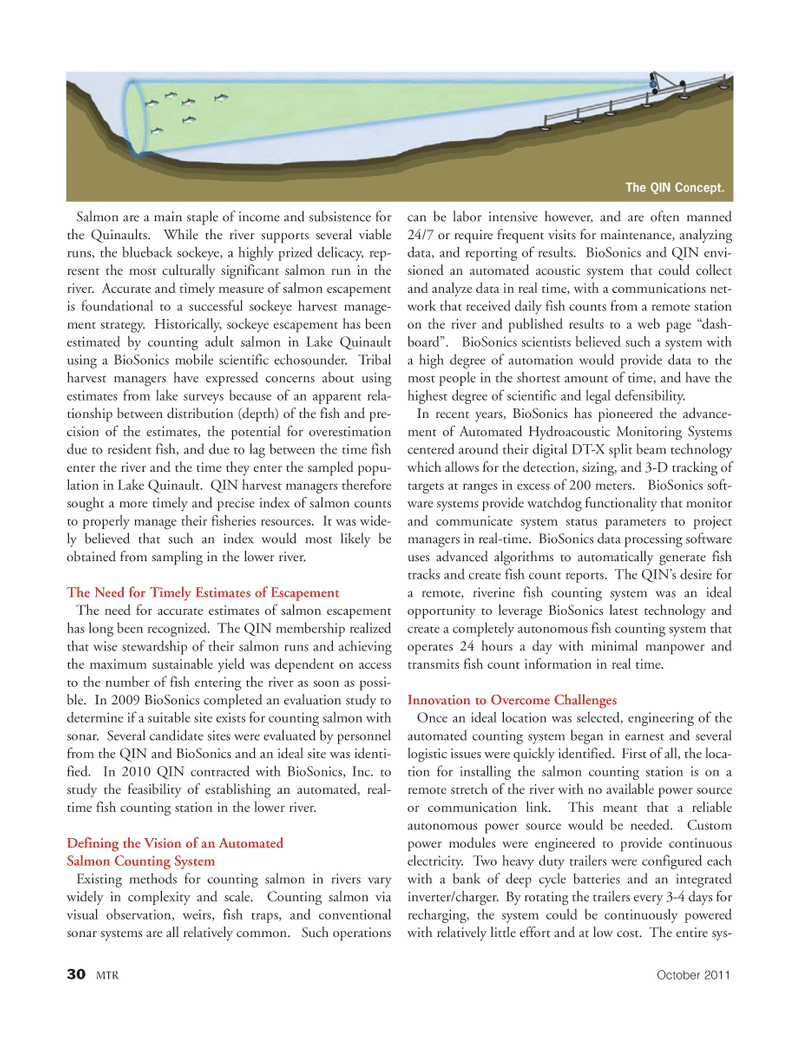
Page 30: of Marine Technology Magazine (October 2011)
Ocean Engineering & Design
Read this page in Pdf, Flash or Html5 edition of October 2011 Marine Technology Magazine
Salmon are a main staple of income and subsistence for the Quinaults. While the river supports several viable runs, the blueback sockeye, a highly prized delicacy, rep- resent the most culturally significant salmon run in the river. Accurate and timely measure of salmon escapement is foundational to a successful sockeye harvest manage- ment strategy. Historically, sockeye escapement has been estimated by counting adult salmon in Lake Quinault using a BioSonics mobile scientific echosounder. Tribal harvest managers have expressed concerns about using estimates from lake surveys because of an apparent rela- tionship between distribution (depth) of the fish and pre- cision of the estimates, the potential for overestimation due to resident fish, and due to lag between the time fish enter the river and the time they enter the sampled popu- lation in Lake Quinault. QIN harvest managers therefore sought a more timely and precise index of salmon counts to properly manage their fisheries resources. It was wide- ly believed that such an index would most likely be obtained from sampling in the lower river. The Need for Timely Estimates of Escapement The need for accurate estimates of salmon escapementhas long been recognized. The QIN membership realized that wise stewardship of their salmon runs and achieving the maximum sustainable yield was dependent on accessto the number of fish entering the river as soon as possi- ble. In 2009 BioSonics completed an evaluation study to determine if a suitable site exists for counting salmon withsonar. Several candidate sites were evaluated by personnel from the QIN and BioSonics and an ideal site was identi- fied. In 2010 QIN contracted with BioSonics, Inc. to study the feasibility of establishing an automated, real- time fish counting station in the lower river. Defining the Vision of an Automated Salmon Counting System Existing methods for counting salmon in rivers vary widely in complexity and scale. Counting salmon viavisual observation, weirs, fish traps, and conventional sonar systems are all relatively common. Such operations can be labor intensive however, and are often manned 24/7 or require frequent visits for maintenance, analyzing data, and reporting of results. BioSonics and QIN envi- sioned an automated acoustic system that could collectand analyze data in real time, with a communications net- work that received daily fish counts from a remote station on the river and published results to a web page ?dash- board?. BioSonics scientists believed such a system with a high degree of automation would provide data to the most people in the shortest amount of time, and have the highest degree of scientific and legal defensibility. In recent years, BioSonics has pioneered the advance- ment of Automated Hydroacoustic Monitoring Systems centered around their digital DT-X split beam technology which allows for the detection, sizing, and 3-D tracking of targets at ranges in excess of 200 meters. BioSonics soft- ware systems provide watchdog functionality that monitor and communicate system status parameters to project managers in real-time. BioSonics data processing software uses advanced algorithms to automatically generate fish tracks and create fish count reports. The QIN?s desire for a remote, riverine fish counting system was an ideal opportunity to leverage BioSonics latest technology and create a completely autonomous fish counting system that operates 24 hours a day with minimal manpower and transmits fish count information in real time. Innovation to Overcome Challenges Once an ideal location was selected, engineering of the automated counting system began in earnest and severallogistic issues were quickly identified. First of all, the loca- tion for installing the salmon counting station is on aremote stretch of the river with no available power source or communication link. This meant that a reliable autonomous power source would be needed. Custom power modules were engineered to provide continuous electricity. Two heavy duty trailers were configured each with a bank of deep cycle batteries and an integrated inverter/charger. By rotating the trailers every 3-4 days for recharging, the system could be continuously powered with relatively little effort and at low cost. The entire sys- 30MTROctober2011 The QIN Concept.MTR#8 (18-33):MTR Layouts 10/10/2011 2:10 PM Page 30

 29
29

 31
31
